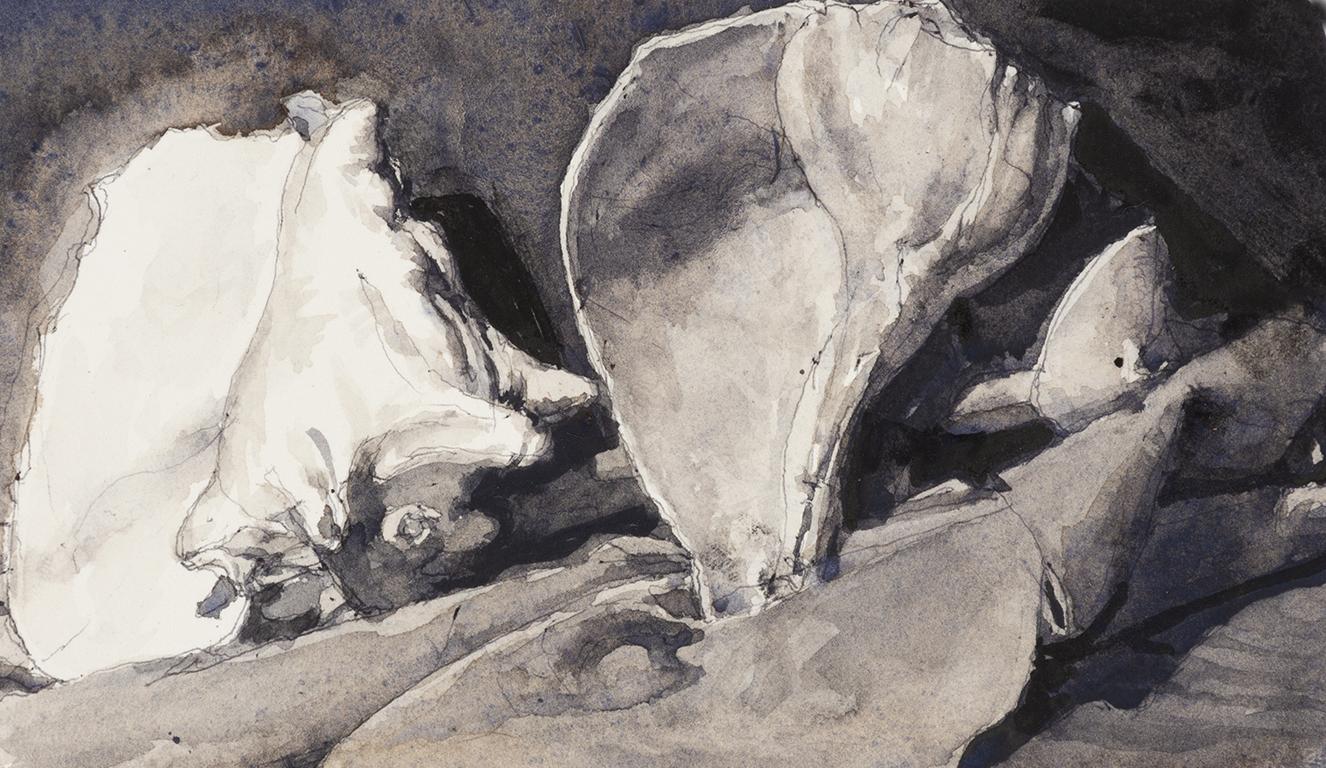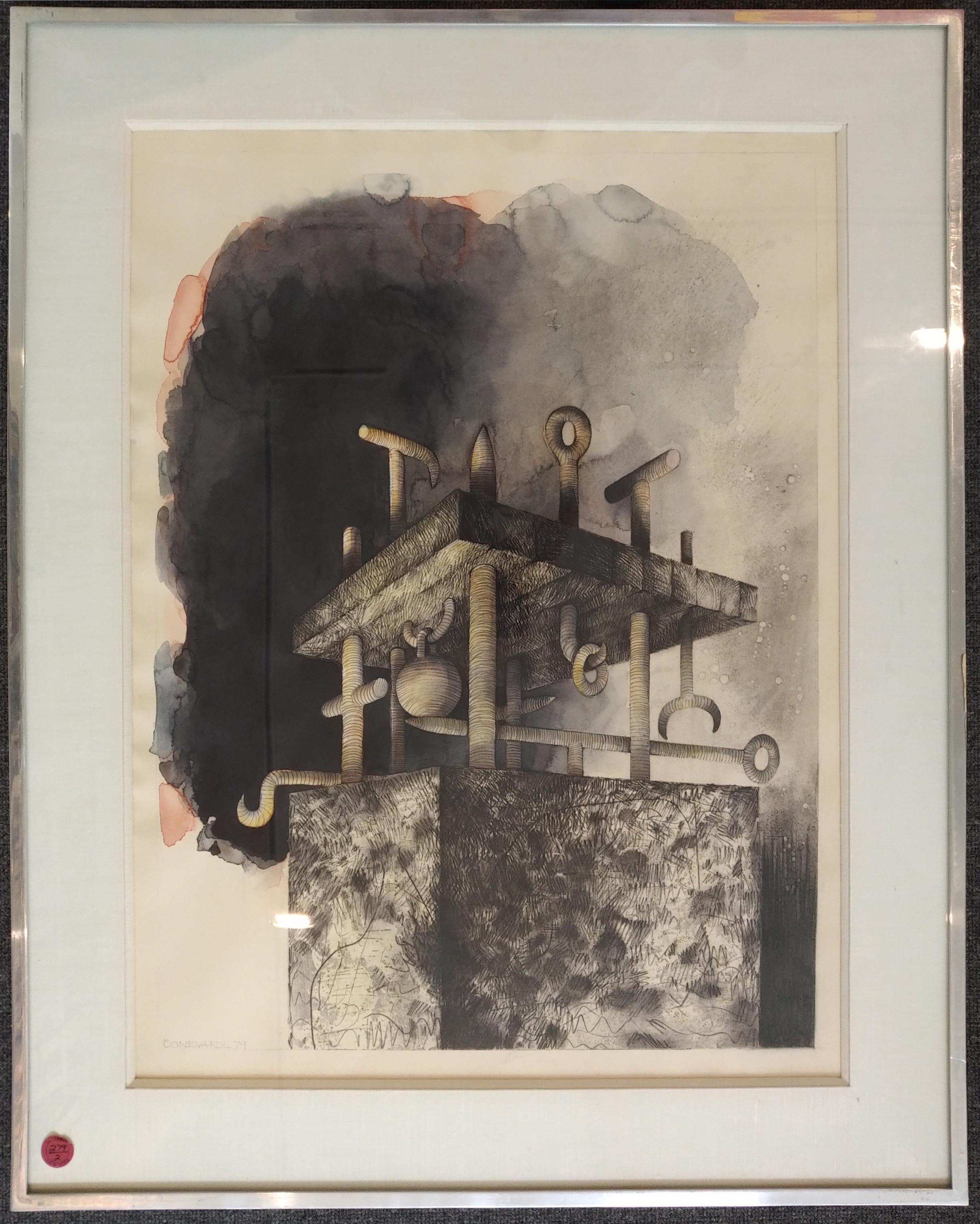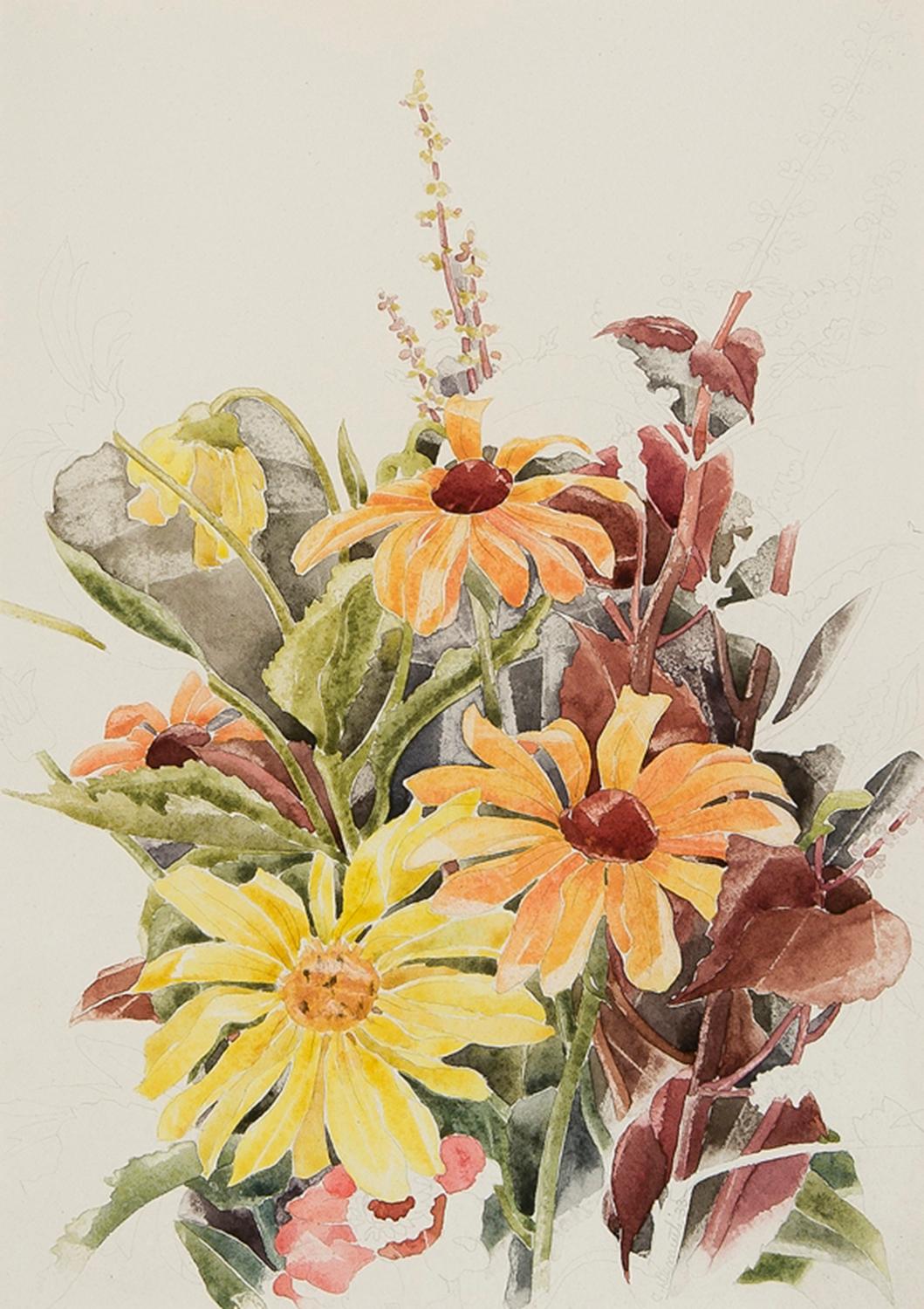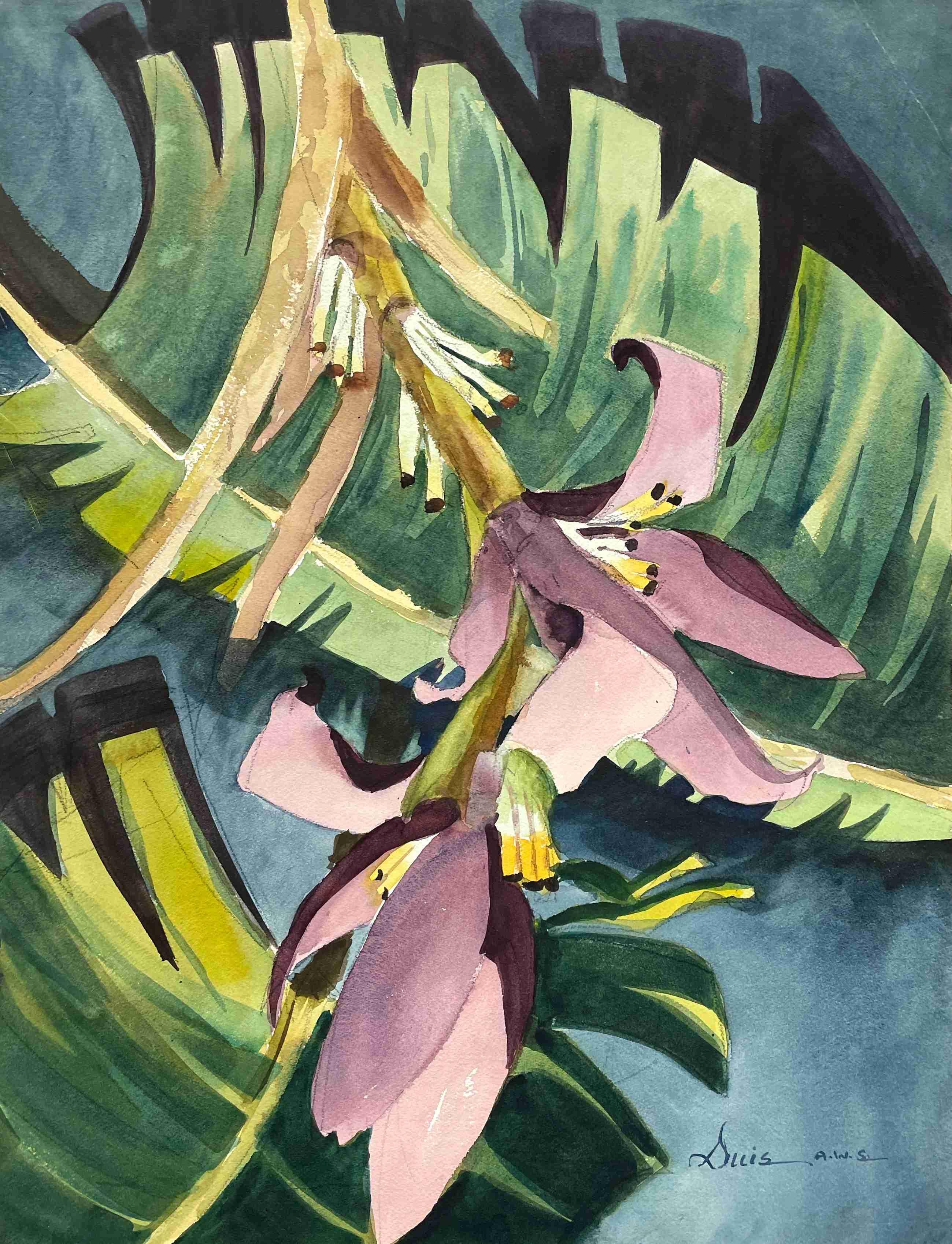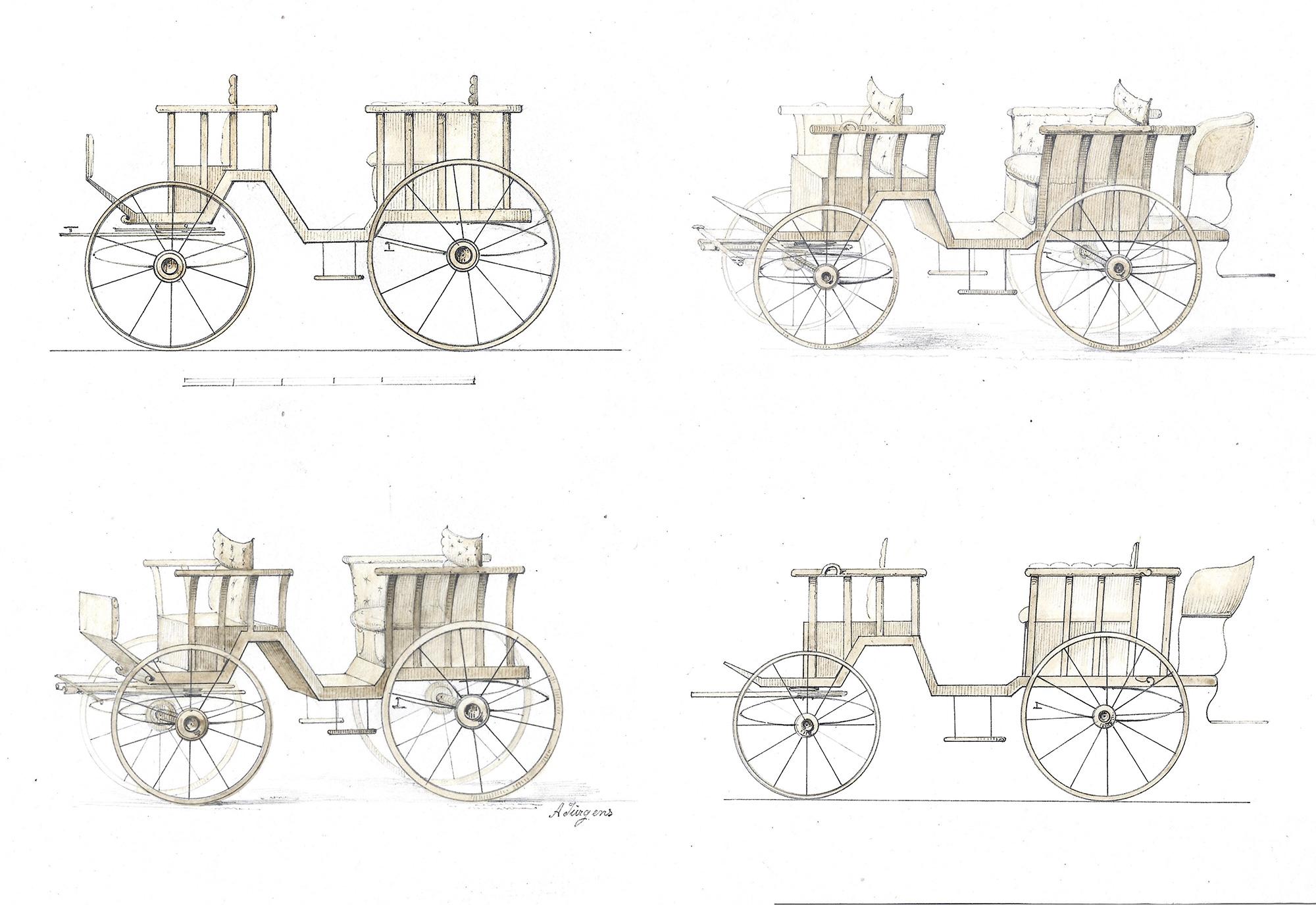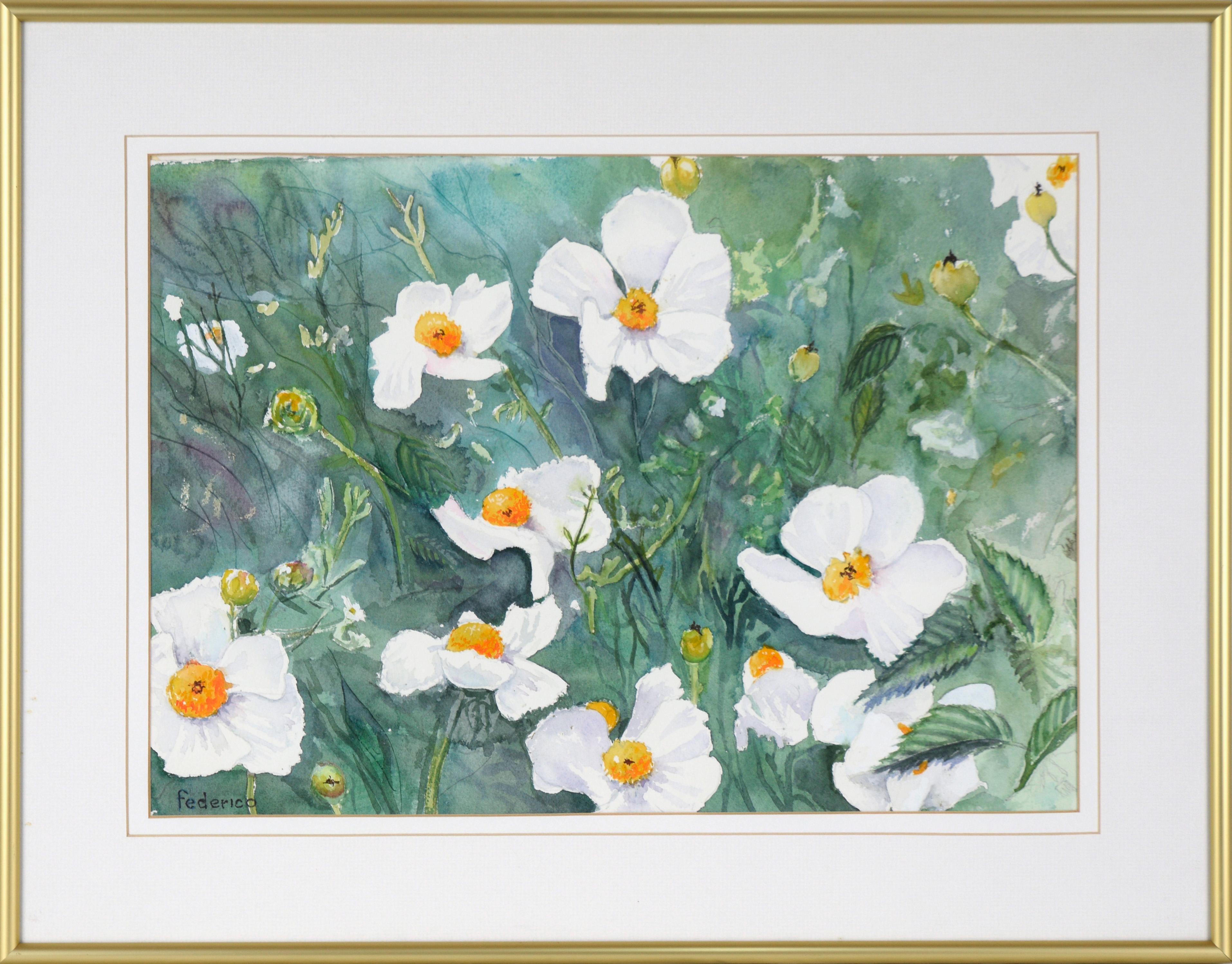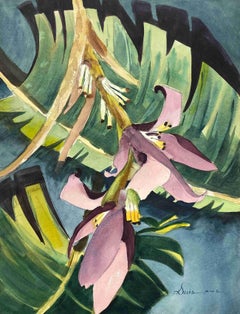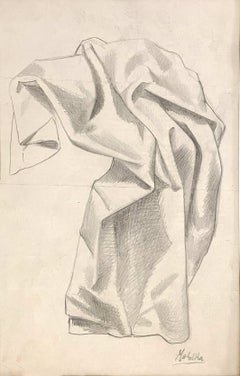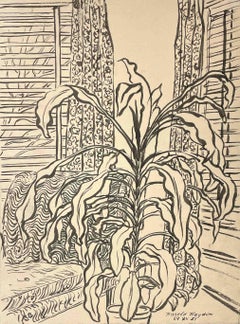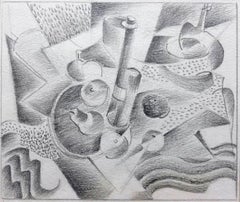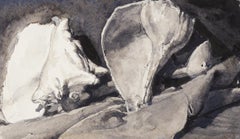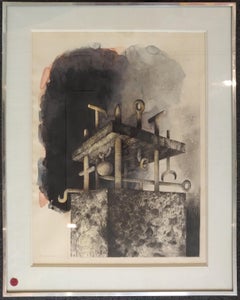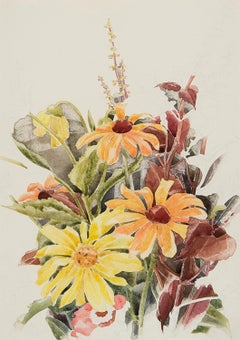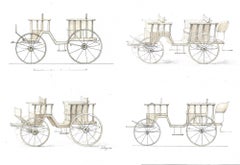Items Similar to Colorful 1950s Watercolor Still-Life Painting by Israel Louis Winarsky
Want more images or videos?
Request additional images or videos from the seller
1 of 9
Israel Louis WinarskyColorful 1950s Watercolor Still-Life Painting by Israel Louis Winarsky1950s
1950s
About the Item
A colorful Modernist, still-life painting of fruit by New Jersey artist Israel Louis Winarsky, archivally matted & in a French Louis XIV-style frame. This work comes from the estate of the artist. Image is double-sided. There is a watercolor of a sailboat on the reverse. Image size: 12" x 18". Framed size: 22 1/2" x 25 1/2".
Known to few in his lifetime,Israel Louis Winarsky epitomizes the discovery of a significant Newark, New Jersey artist. Born in Newark in 1930 of Jewish descent, "Lou" passed his childhood living with his family above his father's butcher shop first located at 295 and then at 372 Hunterdon Street. His artistic journey began with a gift of crayons,his first childhood memory. He soon became enamored of oils,pastels,watercolors and charcoal.
Winarsky attended the local public schools. Between 1944 and 1947, while working part time as a sign painter, he was a student at Weequahic High School. Afterwards, he enrolled at the Newark School of Fine & Industrial Art during the early directorship days of Henry Gasser(1946-1954) and was a student of Samuel Brecher. Later in life he spoke often to his family about Brecher whom Winarsky considered a friend.
In 1951 he earned a B.A. in physics from the University of Chicago and then enlisted in the Air Force, serving some time in Korea as a radioman. In 1961, having painted continuously for over ten years, he traveled around Europe on a motor skooter. In France, Italy and Israel he embraced the people, culture and art and recorded some of his thoughts in letters sent back home to his family.
Winarsky said of himself, "If you want to know who I am, look at my art, my music and my books." While music and books were part of Winarsky's identity, art was his calling.
The paintings and drawings of Winarsky reflect emotion,exuberance and insightful character portrayal. His subject matter ranges from powerful holocaust evocations to jubilant nature and urban interpretations to character explorations. The tragic empathy and gravity that are evident in his Semetic character ensembles are counterbalanced by the uplifting vitality of his colorful landscapes, cityscapes and harbor scenes. Most of his best oil paintings are vibrant expressions of color and form that resonate beauty and probity.
Appropo of Winarsky's varyingly dynamic, often pure and patterned, sometimes quasi-geometric use of color, one wonders about Oscar Bluemner's influence on Winarsky's vision. Much of Winarsky's work could be viewed stylistically as that of an American Colorist in the modified tradition of Bluemner with whose work and color theories Winarsky probably was familiar. Many of Winarsky's landscape paintings fit/pictorially express Bluemner's notion:
"Whatever inner impulse we address towards nature is abstract. Thus, a landscape, as a motive for expression, undergoes a free transformation from objective reality to a subjective realization of personal vision." *Oscar Bluemner: American Colorist , p.23 , Fogg Museum, October 11-November 15, 1967)
Moreover, Winarsky's frequent use of simplified masses in landscapes reflects the influence of both Marsden Hartley and as well as that of Oscar Bluemner.
Combining his preoccupations with World War II history and military aircraft design, Winarsky also painted many watercolors of aerial combat, missions and sorties.
Winarsky was not devoured by the holocaust horror but was indelibly touched by its human lesson. As a result it seems he was emancipated to appreciate the beauty of life and art more not less because of its occurrence.
His style was variably expressionist and impressionist with a modernist flair and a representational base. His palette was zestful, his compositions bold and forthright and oftentimes quite complex. Winarsky, as do most successful artists, has left us with a pictorial range of his interests, attitudes and favorite subject matter in a expressive and effective manner.
As is the case with many modernist artists such as Bluemner, Hartley and Dove, Winarsky did not try to record the literal. He sought to transform it. His subject matter, whether it was a still life, a person or a landscape, was channeled through his transformative sensibilities with an often cogent result.
Winarsky had no other non-service residence other than his family home until 1965. He then married Bernice Kurman and moved to Eastern Parkway in Newark before settling permanently three years later at 299 Short Hills Avenue in Springfield, N.J. , a home on a heavily wooded plot that served as a refuge, studio and subject for Winarsky. He supported his wife,his son & his daughter by working in research and development at Squibb/Bristol Meyers. Despite his more public life in science, privately he was constantly immersed in his lifelong growth as an artist.
Winarsky died of a heart attack in his Springfield home in June of 2006, leaving a large inventory of his passion and vision intact.
Israel Louis Winarsky should be remembered for his beautiful impressionistic landscapes, his holocaust depictions, his urban portrayals, his harbor renderings and his expressionistic character interpretations all of which secure a place for him among New Jersey's most remarkable 20th century artists. He and his work will be featured in an forthcoming book on the Newark School of painters.
Source: Askart
- Creator:Israel Louis Winarsky (1930 - 2006, American)
- Creation Year:1950s
- Dimensions:Height: 22.5 in (57.15 cm)Width: 25.5 in (64.77 cm)
- More Editions & Sizes:Framed Size: 22 1/2" x 25 1/2"Price: $2,500
- Medium:
- Movement & Style:
- Period:
- Condition:See Photos.
- Gallery Location:Chicago, IL
- Reference Number:Seller: #163431stDibs: LU2591213149112
About the Seller
5.0
Recognized Seller
These prestigious sellers are industry leaders and represent the highest echelon for item quality and design.
Established in 2000
1stDibs seller since 2023
40 sales on 1stDibs
Typical response time: <1 hour
- ShippingRetrieving quote...Shipping from: Chicago, IL
- Return Policy
Authenticity Guarantee
In the unlikely event there’s an issue with an item’s authenticity, contact us within 1 year for a full refund. DetailsMoney-Back Guarantee
If your item is not as described, is damaged in transit, or does not arrive, contact us within 7 days for a full refund. Details24-Hour Cancellation
You have a 24-hour grace period in which to reconsider your purchase, with no questions asked.Vetted Professional Sellers
Our world-class sellers must adhere to strict standards for service and quality, maintaining the integrity of our listings.Price-Match Guarantee
If you find that a seller listed the same item for a lower price elsewhere, we’ll match it.Trusted Global Delivery
Our best-in-class carrier network provides specialized shipping options worldwide, including custom delivery.More From This Seller
View AllA Stunning ca. 1950s Cubist Watercolor of Irises by Rita Duis (Astley-Bell)
Located in Chicago, IL
A stunning Cubist watercolor on paper of purple irises by Chicago and New York artist Rita Duis (Astley-Bell). Archivally matted to30" x 24".
Artist Rita Duis (Astley-Bell) led an ...
Category
1950s American Modern Still-life Drawings and Watercolors
Materials
Watercolor, Paper
A ca. 1938 Graphite on Paper Study of Classical Drapery by Modernist Jan Matulka
By Jan Matulka
Located in Chicago, IL
A ca. 1938 graphite on paper, study of a classical drapery by notable Modernist artist Jan Matulka. The image is drawn on the back of a typewritten, folded sheet of stationery, from...
Category
1930s American Modern Still-life Drawings and Watercolors
Materials
Paper, Graphite
1951 Ink on Paper Still Life in an Interior by Artist Harold Haydon
By Harold Haydon
Located in Chicago, IL
A 1951 detailed ink on paper drawing of a still-life in an interior by artist Harold Haydon. Artwork size:
12" x 9". Archivally matted to 16" x 20".
Harold Emerson Haydon was bo...
Category
1950s American Modern Still-life Drawings and Watercolors
Materials
Paper, Ink
Ca. 1945 Cubist Graphite on Paper Still Life Drawing by Artist Stanley Bielecky
By Stanley Bielecky
Located in Chicago, IL
A ca. 1945, Cubist black & white graphite drawing of fruit by artist Illinois and Michigan artist Stanley Bielecky. Image size: 4" x 5". Archivally matted to: 13 1/4" x 16".
Stanley Bielecky was an Indiana artist who painted the American scene, from the factories and workers around East Chicago to the bucolic settings of Mackinac Island...
Category
1940s American Modern Drawings and Watercolor Paintings
Materials
Graphite, Paper
1930s Surrealist Still Life with Profile and Hanger by Artist Jan Matulka
By Jan Matulka
Located in Chicago, IL
A 1930 graphite on pencil drawing of Surrealist still life of an egg beater by notable artist Jan Matulka. Image size: 8 1/2" x 11". Archivally matted to...
Category
1930s Modern Still-life Drawings and Watercolors
Materials
Paper, Graphite
1930s Surrealist Composition of Still Life with Egg Beater by Artist Jan Matulka
By Jan Matulka
Located in Chicago, IL
A 1930s graphite on pencil drawing of Surrealist still life of an egg beater by notable artist Jan Matulka. Artwork size: 8 1/2" x 11". Archivally matted...
Category
1930s Modern Still-life Drawings and Watercolors
Materials
Paper, Graphite
You May Also Like
Tribute to Morandi #29
By Bob Stuth-Wade
Located in Dallas, TX
Bob Stuth-Wade: Tribute to Morandi, 2018
"Life is what happens while I'm thinking of something else."
"Driving. Listening to the radio. Talking on the phone. Thinking of where I'm ...
Category
2010s American Modern Still-life Drawings and Watercolors
Materials
Ink, Paper, Watercolor
UNTITLED No. 26
Located in New York, NY
Avant-Garde
Argentine
Category
1970s American Modern Still-life Drawings and Watercolors
Materials
Paper, Pencil, Watercolor, Charcoal, Conté
Price Upon Request
Garden Flowers
By Charles Demuth
Located in New York, NY
Charles Demuth was one of the most complex, talented, and deeply sensitive artists of the American modern period. Whether he was painting floral still lifes, industrial landscapes, or Turkish bathhouses, art was, for Demuth, fraught with personal meaning. A fixture of the vanguard art scene in New York, Demuth navigated the currents of Modernism, producing some of the most exquisite watercolors and original oil paintings in twentieth-century American art.
Demuth was born in Lancaster, Pennsylvania, the only child of a well-to-do family. He had an awkward and introverted childhood shaped by a childhood illness, Perthes, a disease of the hip that not only left him permanently lame, but, as part of the “cure,” bedridden for two years in the care of his mother. This long period of incapacitation had a deep impact on Demuth, who came to see himself as an invalid, an outsider who was different from everyone else. It was perhaps during this period of indoor confinement that his keen interest in art developed. Several relatives on his father’s side had been amateur artists, and, following his convalescence, his mother encouraged his artistic pursuits by sending him to a local painter for instruction. The majority of his early pictures are of flowers, a subject for which Demuth maintained a lifelong passion.
Following high school, Demuth enrolled at the Drexel Institute of Art in Philadelphia, a school renowned for its commercial arts program. He advanced through the program rapidly, and, in 1905, at the encouragement of his instructors, he began taking courses at the Pennsylvania Academy of the Fine Arts. The two leading teachers then at the Academy were William Merritt Chase and Thomas Anshutz. Anshutz, himself a former student of Thomas Eakins, was well liked by his students, and is best known as the teacher of Robert Henri, John Sloan, and several of the other artists of the Ashcan School. Demuth, too, adopted a similar idiom, working in a controlled, realistic manner while at the Academy, where he remained until 1910.
In 1907, Demuth made his first trip to Europe, staying in Paris. He spent time on the periphery of the art scene composed of the numerous American artists there, including John Marin and Edward Steichen. He returned to Philadelphia five months later, and immediately resumed courses at the Academy. Despite his introduction to advanced modern styles in Europe, Demuth’s work of this period retains the academic style he practiced before the trip. It wasn’t until he had summered at New Hope, Pennsylvania, in 1908 and 1911, that his style began to evolve. New Hope was a prominent American Impressionist art colony whose members were largely affiliated with the Pennsylvania Academy. Demuth dropped the conservative tone of his style and adopted a freer and more colorful palette.
Although he remained based in Philadelphia, Demuth frequently went to New York during this period. Many of the same American artists of the Parisian art scene Demuth had encountered on his earlier European trip now formed the nucleus of New York’s avant-garde, which centered around Alfred Stieglitz’s 291 gallery. It wasn’t long before Demuth began to apply modernist-inspired strategies to his work. He was particularly influenced by the watercolor work of John Marin, also a former student of Anshutz, whose bold use of color in the medium Demuth freely adapted into looser washes of color.
In 1912, Demuth again left for Paris, this time studying in the Académie Moderne, Académie Colorossi, and Académie Julian. In Paris Demuth met the American modernist Marsden Hartley. Hartley, a principal figure in the expatriate art circle, acted as a mentor to Demuth, and introduced him to the wide array of modern styles currently practiced in Europe. Hartley also introduced Demuth to many of the members of the Parisian avant-garde, including Gertrude Stein. Demuth was an aspiring writer, and he spent many hours in conversation with Stein. He wrote extensively during this period, and published two works shortly after his return to America. He also developed an interest in illustrating scenes from literary texts. From 1914 to 1919, Demuth produced a series of watercolors of scenes from books such as Emile Zola’s Nana and Henry James’s The Turn of the Screw.
Upon his return to America, Demuth settled in New York. In 1914, Demuth had his first one-man show at Charles Daniel’s gallery, which promoted emerging modern American artists, including Man Ray, Rockwell Kent, Yasuo Kuniyoshi, Stuart Davis, and Max Weber. Demuth drew closer to the artistic vanguard in New York, becoming friends with many in the Stieglitz and Daniel circles, including Georgia O’Keeffe, Marcel Duchamp, Carl Van Vechten, and Edward Fiske.
New York’s cosmopolitan atmosphere and active nightlife appealed greatly to Demuth. In a sketchy style well suited to watercolor, he painted many vaudeville and circus themes, as well as nightclub, café, and bathhouse scenes. Often with Duchamp, Demuth took part in an urban subculture replete with nightclubs, bars, drugs, and sexual permissiveness, which, for a homosexual artist like himself, allowed room for previously unattainable personal expression. Demuth’s pictures of sailors, bathhouses, and circus performers embody a sensual and sexual undercurrent, expressing the artist’s sense of comfort and belonging in the bohemian subculture of New York.
Simultaneously, Demuth deepened his interest in floral pictures, painting these almost exclusively in watercolor. His style evolved from the broad color washes of his earlier pictures to more spare, flattened, and sinuous compositions, inspired by the drawings of Aubrey Beardsley and other artists of the Aesthetic Movement. Demuth’s flower watercolors are moody and atmospheric, sensuous and elegant, introspective and yet full of expressive power. Moreover they are beautiful, and are unequivocally among the finest still lifes in American art. Despite numerous subsequent artistic undertakings that led him in a variety of directions, Demuth never stopped painting flower pictures, ultimately adding fruits and other still-life objects to his repertoire.
In 1916, Demuth began to develop a style later known as Precisionism, a form of landscape painting infused with Cubism, in which space is divided into precisely drawn geometric regions of color. Demuth first began to paint the landscape in an appropriated Cubist mode while on a trip with Hartley to Bermuda. In these early landscapes, in which the curvilinear forms of trees intersect the geometrically articulated architectural forms, Demuth explored ideas that shaped the future development of modernism in America.
The full realization of Demuth’s explorations came after his return to America in 1917, when he turned his attention to industrial subjects. These works derive from a “machine aesthetic,” espoused by New York artists such as Francis Picabia, Joseph Stella, Albert Gleizes, and Duchamp, by which artists viewed machines as embodying mystical, almost religious significance as symbols of the modern world. Rather than painting the skyscrapers and bridges of New York as did most of his like-minded contemporaries, Demuth returned to his home town of Lancaster, where he painted factories and warehouses in a Precisionist idiom. The titles for these pictures are often contain literary references, which serve as clues for the viewer to aid in the decoding of the artist’s meaning.
In 1923, Demuth planned a series of abstract “poster portraits” of his friends and contemporaries in the New York art and literary scene. In these “portraits,” Demuth combined text and symbolic elements to evoke the essential nature of his sitters’ distinguishing characteristics. In this fashion, he painted portraits of such artists as Georgia O’Keeffe, John Marin, and Arthur Dove. His most famous poster portrait, I Saw the Figure 5 in Gold...
Category
20th Century American Modern Still-life Drawings and Watercolors
Materials
Paper, Watercolor
Kutschen (carriages); Group of four designs for hansom cabs.
By Alfred Juergens
Located in Middletown, NY
Four pencil drawings, each with hand coloring in watercolor, each 6 3/4 x 10 inches (sheet) (172 x 254 mm), full margins. Each with inscriptions and notations by the artist in the up...
Category
Mid-20th Century American Modern Still-life Drawings and Watercolors
Materials
Handmade Paper, Watercolor, Pencil
White Poppies - Botanical Watercolor on Paper
Located in Soquel, CA
White Poppies - Botanical Watercolor on Paper
Detailed floral watercolor by Harry Federico (American, 1922-2022). Several white poppies ...
Category
21st Century and Contemporary American Modern Landscape Drawings and Wat...
Materials
Watercolor, Laid Paper
Dancing Animal Critters on a Top Hat, Bear, Frog, Owl, Crane Bird, Bee, Snail
By Alice and Martin Provensen
Located in Miami, FL
Enter the whimsical world of famed children's book illustrators husband and wife team Alice and Martin Provensen. On top of a heavy tree trunk sits a...
Category
1980s American Modern Animal Drawings and Watercolors
Materials
Gouache
